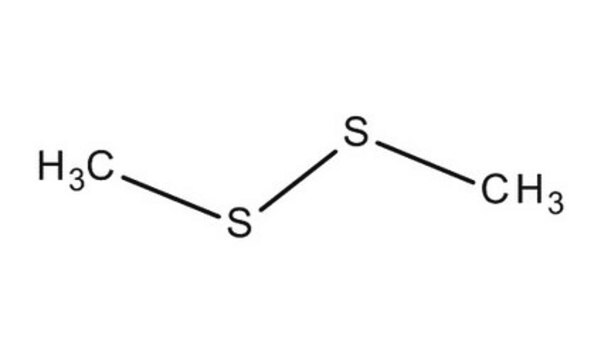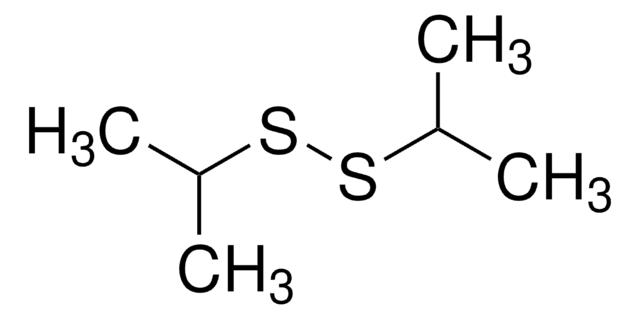W353604
Dimethyl disulfide
≥98%, FG
Synonyme(s) :
DMDS, Methyl disulfide
About This Item
Produits recommandés
Source biologique
synthetic
Qualité
FG
Fragrance grade
Halal
Kosher
Agence
follows IFRA guidelines
meets purity specifications of JECFA
Conformité réglementaire
EU Regulation 1223/2009
EU Regulation 1334/2008 & 178/2002
FDA 21 CFR 172.515
Densité de vapeur
3.24 (vs air)
Pression de vapeur
22 mmHg ( 20 °C)
Essai
≥98%
Température d'inflammation spontanée
>572 °F
Limite d'explosivité
16 %
Indice de réfraction
n20/D 1.525 (lit.)
pb
109 °C (lit.)
Pf
−85 °C (lit.)
Densité
1.046 g/mL at 25 °C (lit.)
Application(s)
flavors and fragrances
Documentation
see Safety & Documentation for available documents
Allergène alimentaire
no known allergens
Allergène de parfum
no known allergens
Propriétés organoleptiques
cabbage; onion; vegetable; sulfurous
Chaîne SMILES
CSSC
InChI
1S/C2H6S2/c1-3-4-2/h1-2H3
Clé InChI
WQOXQRCZOLPYPM-UHFFFAOYSA-N
Vous recherchez des produits similaires ? Visite Guide de comparaison des produits
Catégories apparentées
Application
- GC-IMS-Based Volatile Characteristic Analysis of Hypsizygus marmoreus Dried by Different Methods.: Dimethyl disulfide is used to enhance the aroma of some fresh seafood to, this shows that it can be used to optimize flavor (Lai et al., 2024).
Mention d'avertissement
Danger
Mentions de danger
Conseils de prudence
Classification des risques
Acute Tox. 3 Inhalation - Acute Tox. 3 Oral - Aquatic Acute 1 - Aquatic Chronic 1 - Eye Irrit. 2 - Flam. Liq. 2 - Skin Sens. 1 - STOT SE 1 Inhalation - STOT SE 3
Organes cibles
Central nervous system, Upper respiratory tract
Code de la classe de stockage
3 - Flammable liquids
Classe de danger pour l'eau (WGK)
WGK 3
Point d'éclair (°F)
59.0 °F - closed cup
Point d'éclair (°C)
15 °C - closed cup
Équipement de protection individuelle
Eyeshields, Faceshields, Gloves, type ABEK (EN14387) respirator filter
Faites votre choix parmi les versions les plus récentes :
Déjà en possession de ce produit ?
Retrouvez la documentation relative aux produits que vous avez récemment achetés dans la Bibliothèque de documents.
Les clients ont également consulté
Global Trade Item Number
| Référence | GTIN |
|---|---|
| W353604-10KG-K | 4061837890758 |
| W353604-5KG | |
| W353604-5KG-K | 4061837890765 |
| W353604-SAMPLE | |
| W353604-10KG | |
| W353604-1KG | |
| W353604-1KG-K | 4061837536700 |
| W353604-2KG | |
| W353604-SAMPLE-K | 4061837890772 |
Notre équipe de scientifiques dispose d'une expérience dans tous les secteurs de la recherche, notamment en sciences de la vie, science des matériaux, synthèse chimique, chromatographie, analyse et dans de nombreux autres domaines..
Contacter notre Service technique













